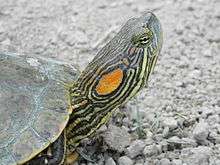Big Bend slider
| Big Bend slider | |
|---|---|
 | |
| Scientific classification | |
| Kingdom: | Animalia |
| Phylum: | Chordata |
| Subphylum: | Vertebrata |
| Class: | Reptilia |
| Order: | Testudines |
| Suborder: | Cryptodira |
| Superfamily: | Testudinoidea |
| Family: | Emydidae |
| Subfamily: | Deirochelyinae[1] |
| Genus: | Trachemys |
| Species: | T. gaigeae |
| Binomial name | |
| Trachemys gaigeae Hartweg, 1939 | |
| Synonyms[2]
Nota bene: Dashes indicate scientific names which are simply new combinations, i.e., not new taxa. | |
| |
The Big Bend slider (Trachemys gaigeae) is a species of aquatic turtle endemic to the Southwestern United States and northern Mexico.
Geographic range
T. gaigeae is native to the United States in the states of New Mexico and Texas, and to northern Mexico in the state of Chihuahua. It is found primarily in the Rio Grande and Rio Conchos river systems.
Etymology
The epithet, gaigeae, is in honor of American herpetologist Helen Beulah Thompson Gaige,[3] who collected the first specimen in the Big Bend region of Texas in 1928.
Taxonomy
The species was first described by professor of zoology at the University of Michigan, Dr. Norman Edouard Hartweg, in 1939. It was for a time considered to be a species of cooter, genus Pseudemys, and then a subspecies of the pond slider, Trachemys scripta, but it was granted full species status, though many sources still refer to it by its various synonyms.
Behavior
Primarily aquatic, Big Bend sliders are often seen basking on rocks or logs in the water, and when approached quickly dive to the bottom. The only time they spend a large amount of time on land is when the females emerge to lay their eggs. They are an omnivorous species, with younger animals being more carnivorous, and progressively becoming more herbivorous as they age, with older adults being nearly entirely herbivorous.
Description
Adults of T. gaigeae have a carapace length of 5 to 11 inches (13 to 28 cm).
Subspecies
- Trachemys gaigeae gaigeae (Hartweg, 1939)
- Trachemys gaigeae hartwegi (Legler, 1990)
References
- ↑ "Trachemys gaigeae ". The Reptile Database. www.reptile-database.org.
- ↑ Fritz, Uwe; Havaš, Peter (2007). "Checklist of Chelonians of the World" (PDF). Vertebrate Zoology. 57 (2): 205. Archived from the original (PDF) on 2010-12-17. Retrieved 29 May 2012.
- ↑ Beolens B, Watkins M, Grayson M. 2011. The Eponym Dictionary of Reptiles. Baltimore: Johns Hopkins University Press. xiii + 296 pp. ISBN 978-1-4214-0135-5. (Trachemys gaigeae, p. 96).
External links
- Species Trachemys gaigeae at The Reptile Database
Further reading
- Behler JL., King FW. 1979. The Audubon Society Field Guide to North American Reptiles and Amphibians. New York: Alfred A. Knopf. 743 pp. ISBN 0-394-50824-6. (Chrysemys scripta gaigeae, p. 453).
- Conant R. 1975. A Field Guide to Reptiles and Amphibians of Eastern and Central North America, Second Edition. Boston: Houghton Mifflin. xviii + 429 pp. + Plates 1-48. ISBN 0-395-19979-4 (hardcover), ISBN 0-395-19977-8 (paperback). (Chrysemys scripta gaigeae, p. 63 + Figure 10 on p. 58 + Map 25).
- Hartweg N. 1939. "A New American Pseudemys ". Occasional Papers of the Museum of Zoology, University of Michigan (397): 1-4. (Pseudemys scripta gaigeae, new subspecies).
- Legler JM. 1990. "Chapter 7. The Genus Pseudemys in Mesoamerica: Taxonomy, Distribution, and Origins". In: Gibbons JW. 1990. Life History and Ecology of the Slider Turtle. Washington, District of Columbia: Smithsonian Institution Press. 368 pp. ISBN 978-0874744682. (Pseudemys scripta hartwegi, new subspecies, pp. 89–91, Figure 7.5, Tables 7.2-7.6).
- Smith HM, Brodie ED Jr. 1982. Reptiles of North America: A Guide to Field Identification. New York: Golden Press. 240 pp. ISBN 0-307-13666-3. (Pseudemys scripta gaigeae, pp. 56–57).
- Stebbins RC. 2003. A Field Guide to Western Reptiles and Amphibians, Third Edition. The Peterson Field Guide Series ®. Boston and New York: Houghton Mifflin Company. xiii + 533 pp. ISBN 978-0-395-98272-3. (Trachemys gaigeae, pp. 253–254 + Plate 21 + Map 69).
